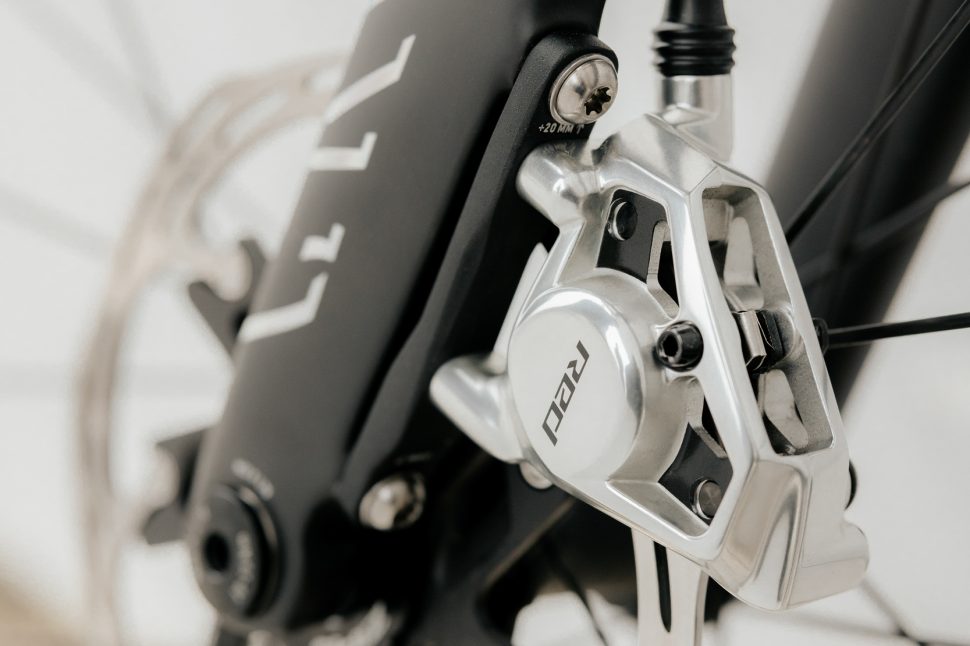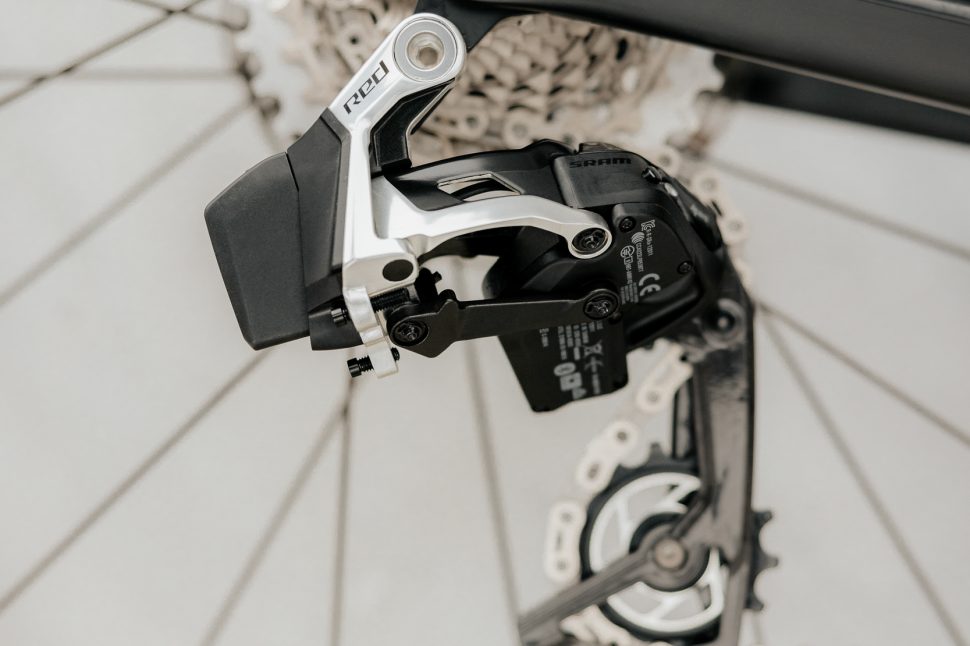Cyclist
SRAM Red AXS reclaims lightest groupset mantle and updates ergonomics
Five years on from its 12-speed AXS overhaul, SRAM has updated its Red AXS groupset. The new design centres around refined control ergonomics and reduced weight, making it more competitive with Shimano’s Dura-Ace in those regards.
Tied to the altered shape of the controls are claimed improvements in braking. SRAM says the new levers provide better modulation and require less effort for the same braking power.
While the chainset has been made a touch lighter, its changes are largely cosmetic and its chainrings and power meter stick to their one-piece arrangement. However, front shifting is said to be faster thanks to a thinner front derailleur cage and new auto-trim function.
Hammerhead’s new Karoo 3 head unit launches at the same time as SRAM Red AXS, having been co-developed with the groupset for heightened integration.
Another of SRAM’s brands, Zipp, gets in on the fun too, releasing new tyres and a new set of bars designed to work the renovated Red levers.
SRAM Red AXS is available immediately as OE on bikes from over 40 brands and aftermarket too, with prices from £4,090 / €4,570 / £4,090.
Cyclist has had the opportunity to test the new SRAM Red AXS groupset over the last few weeks, so be sure to check out our full review.
- Read more: SRAM Red AXS groupset review
- Read more: Hammerhead Karoo 3 has new internals and longer battery life
- Read more: Zipp ups integration with SL 80 Race bar and Goodyear-made Vector R tyres
Seeing the light

If you’ve been to any hill climb event in the last ten years and taken stock of the bikes being raced, without a doubt you’ll have noticed that SRAM’s old Red22 mechanical rim brake groupset was the most common choice on the more committed builds. It wouldn’t have been for the groupset’s shifting and braking abilities – hill climbers don’t do much of either, and while Red22 was fine in those respects, it certainly wasn’t significantly better than Shimano’s Dura-Ace or Campagnolo’s Super Record of similar vintages.
Red22 was the preeminent choice because it was a damn sight lighter than both. Its 1,741g trumped Super Record by over 200g and Dura-Ace 9000 (incidentally, that groupset’s finest ever incarnation) by half that again. However, while subsequent redesigns of Red have undoubtedly increased its functionality, such as the inclusion of disc brakes, wireless electronic shifting and an extra sprocket, they have also increased its weight, to the extent that an equivalent Dura-Ace arrangement has been lighter for a couple of generations now.
Thanks to the modern features that are now a prerequisite in groupset design we’ll never again get down to the dizzyingly light weights of old, but in a contemporary context SRAM says the latest Red revision takes back the lightest groupset mantle.
Give by taking away

‘While it’s dependent on exact setup, new Red AXS is 2,496g,’ says Jason Fowler, SRAM’s road drivetrain product manager. ‘That’s 153g lighter than the previous version, and around 66g lighter than similarly specced Dura-Ace.’
Looking closely at the more skeletal appearance of the new Red groupset, it’s easy to see where SRAM has made plenty of the incremental gains necessary to achieve that weight loss. Cutout chain links contribute 13g, the carriers at the centre of the new Paceline X rotors are more aggressively pared back, shoulder sections of the brake callipers have been removed and the outer plate of the rear derailleur’s parallelogram has been hollowed out (a feature that would no doubt appeal to the hill climbers that have unofficially done similar to their Red22 derailleurs).
Hidden in the tweaked carbon layup of the crank arms, SRAM found another 29g, but by far the biggest contributor to Red’s diet has been at the levers, which the brand says have dropped 41.5g each.
‘That’s a considerable saving so high up the bike,’ says Fowler. ‘It becomes apparent in the swing weight when climbing on the hoods.’
Yet it will be the revised ergonomics of the controls that will be more tangible to riders.

‘We were happy with the shape of the last generation levers, and they’ve remained a success to this day – SRAM Red was used by all six Grand Tour winners last year – but we knew it was an area we could develop,’ says Fowler. ‘Ergonomics aren’t something you can really model on a computer though. Real rider feedback was essential, and it’s been a four-year process to update the controls’ shape.’
Most obviously, the pommel of the controls is much smaller. The length of the body is longer by around six millimetres too.
‘This is to makes them more comfortable to grip when riding on the hoods,’ says Fowler. ‘The smaller pommel fits in the hand more comfortably, and the longer body allows more space for finger wrap underneath.’
This was allowed by shifting the piston arrangement inside the control body. It has gone from a vertical pull-piston in the pommel, where squeezing the brake lever pulls the piston downward to compress the hydraulic fluid and actuate the brakes, to a horizontal push-piston inside the lever body.
‘Rearranging things like this, as well as reshaping the brake levers themselves, also allowed us to manipulate braking modulation. The lever pivot could be much higher, creating more leverage. Along with moving where the brake calliper applies pressure to the rotor further outboard, for the same force it now takes 80% less effort to brake from the hoods and 33% less effort from the drops.’
How and where the braking power is applied isn’t set in stone either, as the levers possess independent adjustment of reach (how far the brake levers sit away from the bars) and contact point (when in the lever travel the brakes engage). SRAM says there should be plenty of scope for both, too, because the shift paddles are now slimmer and longer, so there’s more free space between lever and bars.
Shifting gears

The last time SRAM updated Red, the groupset went to 12-speed. That introduced SRAM’s X-Range gearing concept, which uses a 10t smallest sprocket and more compact chainrings in an attempt to create both close steps and more range.
The groupset also served as the starting point for three overhauled groupset tiers below it, as well as the extension of SRAM’s mix-and-match AXS concept into its road portfolio. It was a biggie, so while it would be fair to say this new SRAM Red AXS groupset’s weight and ergonomic changes validly grab headlines, ultimately it’s a simply a step on from the last generation’s step change.
That is reflected in the gearing this time round. While there are some cosmetic changes in the machined one-piece chainrings, they are offered in the same three pairings (46/33, 48/35, 50/37 , with three extra – 52/39, 54/41, 56/43 – available aftermarket) and SRAM continues with its integrated power meter.
‘I know we’ve taken flack for not making it separate to the rings, but the longer we’ve persevered with the design the more evident it has become that it’s simply not an issue. Our chainrings just don’t really wear out, so the return rate of consumed units has been incredibly low,’ says Fowler.
New cassettes have been added though, with 10-30t and 10-36t options doubling the number of options offered next to the preexisting 10-28t and 10-33t, all using the one-piece machined steel X-DOME construction. SRAM’s ‘Rainbow’ anodised finish is now an option across the board too, chain included.
‘We see it in our AXS app data that the 10t is used a lot by pros, not just in sprints but on descents too, but we wanted to offer more options for climbing,’ says Fowler. ‘It’s common knowledge that riders such as Jonas Vingegaard and Wout van Aert have been pairing the 10-36T with our Red 1x chainring as well.’

Despite the extra ratios, all drivetrain setups are accommodated for with just a single rear derailleur now. SRAM’s well-regarded Orbit Fluid damper is carried over to keep the chain under control, but the pulley wheels have been pepped up: they are now larger and come with hybrid ceramic bearings. It’s the closest one of the groupset makers has come to producing their own OSPW system that specialist third parties such as CeramicSpeed offer as upgrades.

Front shifting has historically not been SRAM’s greatest strength, so Fowler says this was an area of focus this time round.
‘I’d say the first time a rider uses new Red, they’ll notice the ergonomics, then the braking, and the front shifting not long after,’ he says. ‘It’s faster and more precise, thanks to a narrower cage, but there won’t be any risk of rasp because it also has an auto-trim feature, so will micro-adjust depending on where the chain is on the cassette.’
As with the rear derailleur, no matter than chainring pairing the same front derailleur is all that’s required, and SRAM says it aims for setup to be foolproof as well, thanks to a new guide tool.
The digital age

As soon as derailleurs and shifters went from communicating via cables, ratchets and springs to wireless protocols and servos, the potential for head units to play a key part in the function of a groupset was introduced. SRAM is the first to finally fully exploit that promise, as new Red is the first groupset to be co-developed with a head unit.
Hammerhead was acquired by SRAM in 2021, so both the tech brand’s latest Karoo 3 computer and SRAM’s flagship groupset could be developed in-house simultaneously.
‘The latest Karoo build on the Karoo 2 by remaining an incredible computer in its own right, but functions on another level with Red,’ says Fowler. ‘It connects to the groupset automatically, letting you configure shift settings direct from your bars or assess battery status. It works both ways too: the Red hoods have “Bonus Buttons” on the inside of the pommels that we like to set to control pages on the Karoo 3.’

The computer will be supplied with the groupset as standard when it’s bought aftermarket, and appears as OE on stock bikes too. Refreshingly (we’re looking at you, Shimano) though new Red has only just been launched, customers shouldn’t have to search too hard to find it. With the exception of one or two leaks, new Red has gone from being nowhere to everywhere: over 40 bike brands already offer builds and all SRAM’s men’s and women’s pro road teams are now racing on the stuff. Old Red22 might still dominate the niche of hill climbs, but new Red AXS looks set to dominate almost everywhere else.
SRAM Red AXS weights and pricing
New SRAM Red AXS is available in several guises. It is offered on stock builds from the following manufacturers:

The groupset can be bought aftermarket too. Base price is £3,000 / €3,350 / $3,000, that includes a Hammerhead Karoo 3 computer, but not a chainset or cassette. Their cost is extra and varies dependent on spec:
Cassettes:
- From £390/435€/$390 to £410/460€/$410
- From £450/505€/$450 to £470/525€/$470 in a rainbow finish
Chainsets:
- With PM: £1,200/1345€/$1,200
- Non-PM: £700/785€/$700
The larger chainring pairings (52/39, 54/41, 56/43) and the 48T and 52T 1x chainrings must be bought individually:
- Cranks: £400/450€/$400
- Chainrings: £800/895€/$800 (includes PM). Non-PM 48T is at $240/270€/£240
Claimed weights for individual components of the groupset in both PM and non-PM equipped guises, versus previous generation Red eTap AXS, are as follows:

- For more information on the new SRAM Red AXS groupset, visit sram.com
- Read more: SRAM Red AXS groupset review
- Read more: Hammerhead Karoo 3 has new internals and longer battery life
- Read more: Zipp ups integration with SL 80 Race bar and Goodyear-made Vector R tyres
The post SRAM Red AXS reclaims lightest groupset mantle and updates ergonomics appeared first on Cyclist.